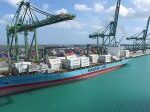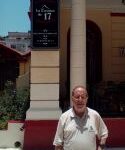It’s hard encapsulate all that happened today (and it’s only 6 pm), which included a Scoutmaster from Normal Illinois attempting at lunch to top the performance last year of the Rolling Stones, who attracted one million Cubans; read to the end to get the exact admission (as if you didn’t guess). And who knew there was a Napoleon museum here in Havana that had the largest collection of Napoleona outside of Paris? Or that, miracle, we would get back early enough to visit it?
I had no idea how the day would unfold when we drove the 45 km to the constructed special economic zone of Mariel, a 464 km2 area set aside for the development of a deep water port to restore the greatness of the Havana  port which has grown too small for the big container ships (38x the size of those of the 50s, necessitating as well the widening of the Panama Canal); it was in Havana harbor that the galleons gathered from the far-flung reaches of the Spanish empire (from Manila, Peru, and Mexico) before the long trek in convoy (to evade the predatory European pirates) to Seville. Though 45 km from Havana, it connects into the rail system–and wages are ten times those in the rest of the country.
port which has grown too small for the big container ships (38x the size of those of the 50s, necessitating as well the widening of the Panama Canal); it was in Havana harbor that the galleons gathered from the far-flung reaches of the Spanish empire (from Manila, Peru, and Mexico) before the long trek in convoy (to evade the predatory European pirates) to Seville. Though 45 km from Havana, it connects into the rail system–and wages are ten times those in the rest of the country.
One of the advantages of the “planned economy” is that the government can say, “Do this” and it gets done. That’s more or less what happened with this new port a few years ago–dredging, then hiring PSA International of Singapore to manage the operation, one of the leading operators of ports around the world (Singapore usually leads the world in transshipping). Our host was Argentinian, and he had lots of good things to say about being an expatriate in Cuba, particularly the safety–there doesn’t seem to be any overt dissatisfaction — and good international schools. As I said, this seems to be a pattern in the joint ventures–hiring managers for expertise–but the zone designed to let foreign-owned companies locate here. It was after all, the special economic zones Deng Xiao-ping established in China that propelled much of China’s economic miracle. For the long term, as with some of the other businesses we’ve visited, reaching the goal of creating a transshipping and manufacturing center will require an end to the US embargo. Given that the population of Cuba is only 11 million, and we keep being told it is a poor country (Raul noted that when he became president, he canceled some of the retirement benefits; retirees get a small stipend, but essentially you have to plan ahead for your retirement), the future depends on the ability to utilize the geographic location–within 500 miles of major port cities, including Houston, Miami, Charleston, etc. Currently, 90% of the containers are destined for Cuba. As I mentioned, ships that stop here cannot dock in US ports for 6 months.
It’s always fun for me to see logistics operations, with the huge cranes that lift the containers off the boats and onto trucks or train cars. The cranes were made in China, one of the few connections I’ve seen here with the Middle Kingdom. Cuba was in the Russian sphere of influence for 30 years, and that shows in lots of places. Lada cars anyone? The last time I rode in one, I was in Tsingtao, China, with Mike Seeborg, pushing the Lada up a hill.One of the Russian connections is in the realm of cooperatives. We had a talk from a lawyer a few days ago about these instruments for economic development, and two visits to cooperatives. One was a restaurant, reputedly the first restaurant cooperative, which like many of the cooperatives (rather like Green Top in Bloomington, where you put money in and run the company) started with contributions of 7000 pesos, and a loan of 35000 CUC (each CUC=25 pesos). Our guide said it was one of the few successful cooperative restaurants.
 There was a guitar trio, and this Scoutmaster from central Illinois could not help himself, and so, to the amusement (or was it the embarrassment) of all, plucked through two verses of Fairview stew. Despite entreaties to play at the same stadium as Mick and the Stones, the modest Scoutmaster ended his Cuban tour in favor of lunch.
There was a guitar trio, and this Scoutmaster from central Illinois could not help himself, and so, to the amusement (or was it the embarrassment) of all, plucked through two verses of Fairview stew. Despite entreaties to play at the same stadium as Mick and the Stones, the modest Scoutmaster ended his Cuban tour in favor of lunch.
The next cooperative, a car restoration facility, was state owned, when the state recommended (one of the directives from the Soviet inspiration) to turn it into a coop. The 48 owners (now 200) have in the two years boasted of their voluntary association, economic participation, community involvement, and being self managed and consultative in decision making. They choose their own executives. What was interesting to me, though, was despite the semi-socialist rhetoric, their strategic plan came straight from Harvard–a strengths/ weaknesses analysis, followed by a Michael Porter analysis, then a tour through the plant which reconstructs cars, trucks, and buses. The plant does panel beating (honest), painting, reupholstery and assembly/reassembly. With the expense of cars (I think the guide told us one luxury car goes for $265,000; two were sold), and the age of cars (US cars to the late 50s; Russian cars from the 80s), repair maybe the easier (or only) way to go. The bill is around $4000–and the terms are net 30. There’s no financing. This is a cash economy, even if some businesses have credit card signs to lure tourists in.
 We got back early enough that I took advantage and went to the Museum Napoleon. Who knew the Emperor lived in Cuba (as I recall he was so disgusted with the French possessions in the new world that he sold Louisiana to the United States)? He did not, but a rich Cuban decided to collect memorabilia, and wound up with four floors of it in a wonderful neo-Renaissance villa built in the 1920s, that alone was worth the price of free admission.
We got back early enough that I took advantage and went to the Museum Napoleon. Who knew the Emperor lived in Cuba (as I recall he was so disgusted with the French possessions in the new world that he sold Louisiana to the United States)? He did not, but a rich Cuban decided to collect memorabilia, and wound up with four floors of it in a wonderful neo-Renaissance villa built in the 1920s, that alone was worth the price of free admission.
And it’s only 630 now. Off to do more. Maybe play the guitar again. After all, the 14 faculty on the trip applauded…..